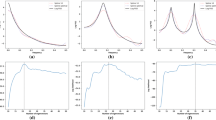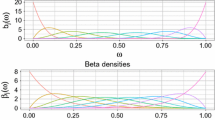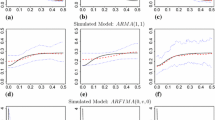Abstract
This article proposes a Bayesian approach to estimating the spectral density of a stationary time series using a prior based on a mixture of P-spline distributions. Our proposal is motivated by the B-spline Dirichlet process prior of Edwards et al. (Stat Comput 29(1):67–78, 2019. https://doi.org/10.1007/s11222-017-9796-9) in combination with Whittle’s likelihood and aims at reducing the high computational complexity of its posterior computations. The strength of the B-spline Dirichlet process prior over the Bernstein–Dirichlet process prior of Choudhuri et al. (J Am Stat Assoc 99(468):1050–1059, 2004. https://doi.org/10.1198/016214504000000557) lies in its ability to estimate spectral densities with sharp peaks and abrupt changes due to the flexibility of B-splines with variable number and location of knots. Here, we suggest to use P-splines of Eilers and Marx (Stat Sci 11(2):89–121, 1996. https://doi.org/10.1214/ss/1038425655) that combine a B-spline basis with a discrete penalty on the basis coefficients. In addition to equidistant knots, a novel strategy for a more expedient placement of knots is proposed that makes use of the information provided by the periodogram about the steepness of the spectral power distribution. We demonstrate in a simulation study and two real case studies that this approach retains the flexibility of the B-splines, achieves similar ability to accurately estimate peaks due to the new data-driven knot allocation scheme but significantly reduces the computational costs.





Similar content being viewed by others
References
Bremhorst V, Lambert P (2016) Flexible estimation in cure survival models using Bayesian p-splines. Comput Stat Data Anal 93:270–284. https://doi.org/10.1016/j.csda.2014.05.009
Brockwell PJ, Davis RA (1991) Time series: theory and methods. Springer, New York, USA, 2 edn, ISBN 978-0-387-97429-3. https://doi.org/10.1007/978-1-4419-0320-4
Cadonna A, Kottas A, Prado R (2017) Bayesian mixture modeling for spectral density estimation. Stat Probab Lett 125:189–195. https://doi.org/10.1016/j.spl.2017.02.008
Carter CK, Kohn R (1997) Semiparametric Bayesian inference for time series with mixed spectra. J R Stat Soc Ser B 59(1):255–268. https://doi.org/10.1111/1467-9868.00067
Choudhuri N, Ghosal S, Roy A (2004) Bayesian estimation of the spectral density of a time series. J Am Stat Assoc 99(468):1050–1059. https://doi.org/10.1198/016214504000000557
Edwards MC, Meyer R, Christensen N (2018) bsplinePsd: Bayesian nonparametric spectral density estimation using b-spline priors, https://CRAN.R-project.org/package=bsplinePsd. R package version 0.6.0
Edwards M, Meyer R, Christensen N (2019) Bayesian nonparametric spectral density estimation using b-spline priors. Stat Comput 29(1):67–78. https://doi.org/10.1007/s11222-017-9796-9
Eilers PHC, Marx BD (1996) Flexible smoothing with b-splines and penalties. Stat Sci 11(2):89–121. https://doi.org/10.1214/ss/1038425655
Eilers, Paul H. C, Marx, Brian D, Durbán María (2015) Twenty years of p-splines. SORT: statistics and operations research transactions, 39(2), ISSN 1696-2281. http://hdl.handle.net/2117/88526
Gangopadhyay AK, Mallick BK, Denison DGT (1999) Estimation of spectral density of a stationary time series via an asymptotic representation of the periodogram. J Stat Plan Inference 75(2):281–290. https://doi.org/10.1016/S0378-3758(98)00148-7
Green PJ (1995) Reversible jump Markov chain Monte Carlo computation and Bayesian model determination. Biometrika 82(4):711–732. https://doi.org/10.1093/biomet/82.4.711
Huerta G, West M (1999) Bayesian inference on periodicities and component spectral structure in time series. J Time Ser Anal 20(4):401–416. https://doi.org/10.1111/1467-9892.00145
Jullion A, Lambert P (2007) Robust specification of the roughness penalty prior distribution in spatially adaptive Bayesian p-splines models. Comput Stat Data Anal 51(5):2542–2558. https://doi.org/10.1016/j.csda.2006.09.027
Kauermann G, Opsomer JD (2011) Data-driven selection of the spline dimension in penalized spline regression. Biometrika 98(1):225–230
Kirch C, Edwards MC, Meier A, Meyer R (2018) Beyond Whittle: nonparametric correction of a parametric likelihood with a focus on Bayesian time series analysis. Bayesian Anal. https://doi.org/10.1214/18-BA1126
Krivobokova Tatyana, Kauermann Gran, Archontakis Theofanis (2006) Estimating the term structure of interest rates using penalized splines. Stat Papers 47(3):443–459
Lambert P (2007) Archimedean copula estimation using Bayesian splines smoothing techniques. Comput Stat Data Anal 51(12):6307–6320. https://doi.org/10.1016/j.csda.2007.01.018
Lang S, Brezger A (2004) Bayesian p-splines. J Comput Graph Stat 13(1):183–212. https://doi.org/10.1198/1061860043010
Likhachev DV (2017) Selecting the right number of knots for b-spline parameterization of the dielectric functions in spectroscopic ellipsometry data analysis. Thin Solid Films 636:519–526. https://doi.org/10.1016/j.tsf.2017.06.056
Maturana-Russel P, Meyer R (2020) psplinePsd: P-splines for spectral density estimation, https://github.com/pmat747/psplinePsd
Meier A, Kirch C, Meyer R (2020) Bayesian nonparametric analysis of multivariate time series: a matrix gamma process approach. J Multivariate Anal, 175, ISSN 0047-259X
Pawitan Y, O’sullivan F, (1994) Nonparametric spectral density estimation using penalized whittle likelihood. J Am Stat Assoc 89(426):600–610. https://doi.org/10.1080/01621459.1994.10476785
Pensky M, Vidakovic B, De Canditiis D (2007) Bayesian decision theoretic scale-adaptive estimation of a log-spectral density. Stat Sin 17:635–666
Perron F, Mengersen K (2001) Bayesian nonparametric modeling using mixtures of triangular distributions. Biometrics 57(2):518–528
Petrone S (1999) Random Bernstein polynomials. Scand J Stat 26(3):373–393. https://doi.org/10.1111/1467-9469.00155
Petrone S (1999) Bayesian density estimation using Bernstein polynomials. Can J Stat/La Revue Canadienne de Statistique 27(1):105–126
Polson NG, James G, Scott JW (2013) Bayesian inference for logistic models using PólyaGamma latent variables. J Am Stat Assoc 108(504):1339–1349. https://doi.org/10.1080/01621459.829001
Ramsay JO, Wickham H, Graves S, Hooker G (2020) fda: functional data analysis. https://CRAN.R-project.org/package=fda. R package version 2.4.8.1
Rodrguez-lvarez M, Durban M, Lee D-J, Eilers P (2019) On the estimation of variance parameters in non-standard generalised linear mixed models: application to penalised smoothing. Stat Comput 29(3):483–500
Rosen O, Wood S, Stoffer DS (2012) Adaptspec: adaptive spectral estimation for nonstationary time series. J Am Stat Assoc 107(500):1575–1589. https://doi.org/10.1080/01621459.2012.716340
Ruppert D (2002) Selecting the number of knots for penalized splines. J Comput Graph Stat 11(4):735–757. https://doi.org/10.1198/106186002853
Sethuraman J (1994) A constructive definition of Dirichlet priors. Stat Sin 4:639–650
Shao X, Wu WB (2007) Asymptotic spectral theory for nonlinear time series. Ann Stat 35(4):1773–1801
Wand M P, Ormerod J T (2008) On semiparametric regression with O’Sullivan penalized splines. Aust NZ J Stat 50(2):179–198
Wegener Michael, Kauermann Goran (2017) Forecasting in nonlinear univariate time series using penalized splines. Stat Papers 58(3):557
Whittle P (1957) Curve and periodogram smoothing. J R Stat Soc Ser B (Methodological) 19(1):38–63
Wood S (2017) P-splines with derivative based penalties and tensor product smoothing of unevenly distributed data. Stat Comput 27(4):985–989
Wood SN, Fasiolo M (2017) A generalized fellnerschall method for smoothing parameter optimization with application to tweedie location, scale and shape models. Biometrics 73(4):1071–1081
Acknowledgements
We thank Thomas Yee for helpful discussions on P-splines. We also thank the New Zealand eScience Infrastructure (NeSI) for their high performance computing facilities, and the Centre for eResearch at the University of Auckland for their technical support. PM’s and RM’s work is supported by Grant 3714568 from the University of Auckland Faculty Research Development Fund and the DFG Grant KI 1443/3-1. RM gratefully acknowledges support by a James Cook Fellowship from Government funding, administered by the Royal Society Te Apārangi. All analysis was conducted in R, an open-source statistical software available on CRAN (cran.r-project.org).
Author information
Authors and Affiliations
Corresponding author
Additional information
Publisher's Note
Springer Nature remains neutral with regard to jurisdictional claims in published maps and institutional affiliations.
Rights and permissions
About this article
Cite this article
Maturana-Russel, P., Meyer, R. Bayesian spectral density estimation using P-splines with quantile-based knot placement. Comput Stat 36, 2055–2077 (2021). https://doi.org/10.1007/s00180-021-01066-7
Received:
Accepted:
Published:
Issue Date:
DOI: https://doi.org/10.1007/s00180-021-01066-7




